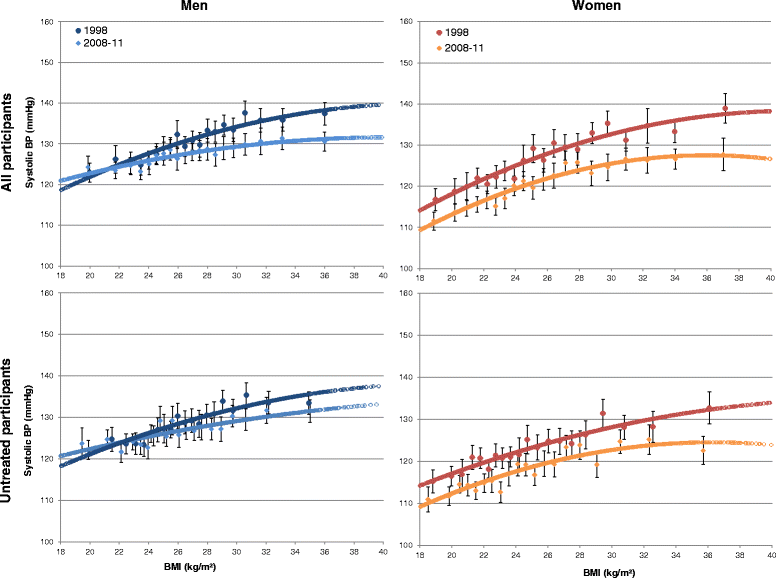Change in the association of body mass index and systolic blood pressure in Germany - national cross-sectional surveys 1998 and 2008-2011
- PMID: 26209098
- PMCID: PMC4514940
- DOI: 10.1186/s12889-015-2023-8
Change in the association of body mass index and systolic blood pressure in Germany - national cross-sectional surveys 1998 and 2008-2011
Abstract
Background: A recent weakening and even decoupling of the association of body mass index (BMI) and systolic blood pressure (SBP) in population data was reported, i. a. for Western Europe.
Methods: The association of BMI and SBP in recent cross-sectional population data from Germany was investigated in participants aged 18-79 years with BMI 17.5-40 kg/m(2) from national health examination surveys 1998 (n = 6,931) and 2008-2011 (n = 6,861) in Germany. The association was analyzed both in the overall samples and in participants without antihypertensive medication.
Results: From 1998 to 2008-11, age- and sex-standardized mean SBP decreased from 129.0 (CI 128.2-129.7) to 124.1 (123.5-124.6) mmHg in all participants and from 126.0 (125.4-126.7) to 122.3 (121.7-122.8) mmHg among persons not on antihypertensive medication. The proportion of persons treated with antihypertensives augmented from 19.2 % (17.7-20.8) to 25.3 % (24.0-26.6). Mean BMI remained constant at around 27 kg/m(2) with a slight increase in obesity prevalence. BMI was positively associated with SBP both in 1998 and 2008-11, yet the association tended to level out with increasing BMI suggesting a non-linear association. The strength of the BMI-SBP-association decreased over time in all and untreated men. In women, the association weakened in the overall sample, but remained similarly strong in untreated women. The unadjusted linear regression models were used to estimate the increase in SBP within 5-unit BMI increases. E. g. for men in 1998, SBP was higher by 7.0 mmHg for a BMI increase from 20 to 25 kg/m(2) and by 3.6 mmHg for BMI 30 to 35 kg/m(2). The corresponding values for 2008-11 were 3.8 mmHg and 1.7 mmHg.
Conclusions: The cross-sectional association of BMI and SBP decreased between 1998 and 2008-11 in Germany, however it did not disappear and it is in part explained by improvements in the diagnosis and treatment of high blood pressure.
Figures
Similar articles
-
Body mass index, abdominal adiposity and blood pressure: consistency of their association across developing and developed countries.Int J Obes Relat Metab Disord. 2002 Jan;26(1):48-57. doi: 10.1038/sj.ijo.0801854. Int J Obes Relat Metab Disord. 2002. PMID: 11791146
-
[Risk factors associated with the prevalence of arterial hypertension in adults in Bucaramanga, Colombia].Salud Publica Mex. 2002 Sep-Oct;44(5):399-405. Salud Publica Mex. 2002. PMID: 12389482 Spanish.
-
Change in body mass index and its impact on blood pressure: a prospective population study.Int J Obes (Lond). 2005 Jun;29(6):650-5. doi: 10.1038/sj.ijo.0802944. Int J Obes (Lond). 2005. PMID: 15809666
-
Trends in population blood pressure and determinant factors for population blood pressure.Dan Med J. 2017 Mar;64(3):B5353. Dan Med J. 2017. PMID: 28260600
-
Blood pressure and obesity in childhood and adolescence. Epidemiologic aspects.Ann Epidemiol. 1991 May;1(4):337-45. doi: 10.1016/1047-2797(91)90044-d. Ann Epidemiol. 1991. PMID: 1669515 Review.
Cited by
-
Exercise capacity, cardiovascular and metabolic risk of the sample of German police officers in a descriptive international comparison.Int J Med Sci. 2021 May 27;18(13):2767-2775. doi: 10.7150/ijms.60696. eCollection 2021. Int J Med Sci. 2021. PMID: 34220304 Free PMC article.
-
Development of the simulation-based German albuminuria screening model (S-GASM) for estimating the cost-effectiveness of albuminuria screening in Germany.PLoS One. 2022 Jan 5;17(1):e0262227. doi: 10.1371/journal.pone.0262227. eCollection 2022. PLoS One. 2022. PMID: 34986199 Free PMC article.
-
Changes in the body mass index and blood pressure association across time: Evidence from multiple cross-sectional and cohort studies.Prev Med. 2021 Dec;153:106825. doi: 10.1016/j.ypmed.2021.106825. Epub 2021 Sep 30. Prev Med. 2021. PMID: 34599929 Free PMC article.
-
Secular Trends of the Impact of Overweight and Obesity on Hypertension in Yi People: Yi Migrant Study, 1996-2015.Int J Hypertens. 2020 Mar 29;2020:5368357. doi: 10.1155/2020/5368357. eCollection 2020. Int J Hypertens. 2020. PMID: 32292597 Free PMC article.
-
Trends in the association between body mass index and blood pressure among 19-year-old men in Korea from 2003 to 2017.Sci Rep. 2022 Apr 26;12(1):6767. doi: 10.1038/s41598-022-10570-9. Sci Rep. 2022. PMID: 35473938 Free PMC article.
References
-
- Lim SS, Vos T, Flaxman AD, Danaei G, Shibuya K, Adair-Rohani H, AlMazroa MA, Amann M, Anderson HR, Andrews KG, et al. A comparative risk assessment of burden of disease and injury attributable to 67 risk factors and risk factor clusters in 21 regions, 1990–2010: a systematic analysis for the Global Burden of Disease Study 2010. Lancet. 2012;380(9859):2224–60. doi: 10.1016/S0140-6736(12)61766-8. - DOI - PMC - PubMed
Publication types
MeSH terms
LinkOut - more resources
Full Text Sources
Other Literature Sources
Medical


